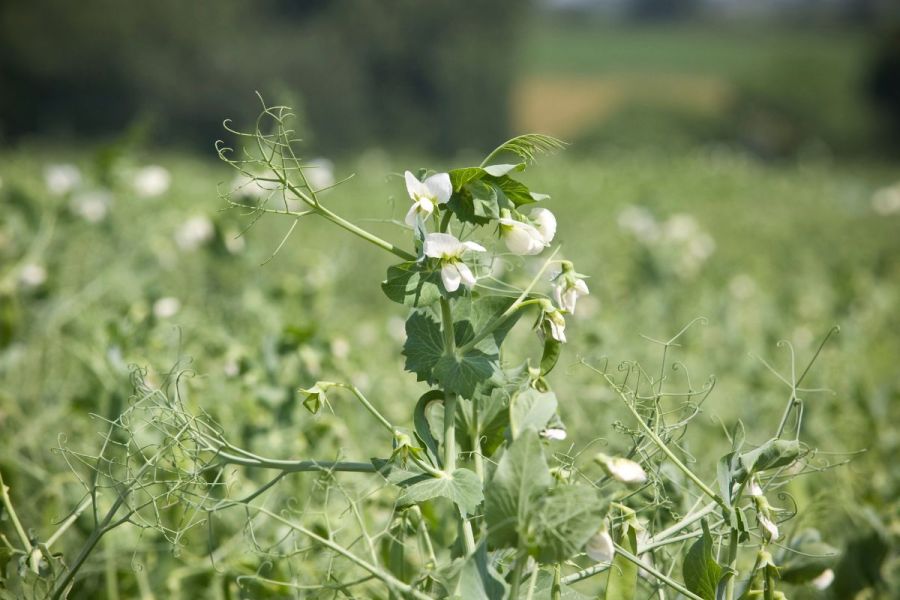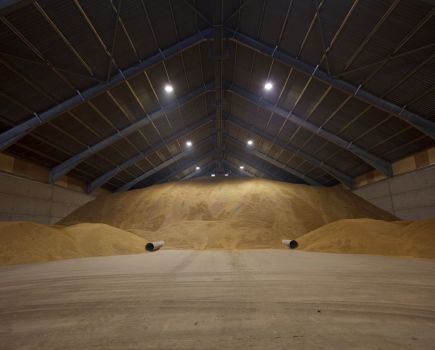With a focus on legumes in a number of the options available under the new SFI scheme, experts warn that careful consideration should be given to how they’re grown to avoid future problems. CPM finds out more.
“For the sustainability of the UK pulse industry, it’s vital that options are selected and managed effectively to prevent future issues.”
By Charlotte Cunningham
Although from the outset the SFI scheme looks to benefit both crop and soil health, and the wider environment, lack of careful planning when it comes legume-containing options could negatively impact the longer-term outlook for pulses.
This is according to the Processors and Growers Research Organisation, which is warning growers to be cautious when it comes to selecting and growing new SFI options during the coming year.
“As a general overview, the SFI is positive and there are several options available to growers that have good payments attached to them,” explains PGRO’s Dr Becky Howard. “That said, a number of these will likely include legumes in the mixtures and will therefore require careful management.”
Becky says that options, including NUM3 and IPM3, encourage either longer-term or frequent short-term use of legume species. “There’s also the AHL1 pollen and nectar flower mixture which features a high percentage of legumes in some of the blends – up to 99% in some cases.”
The challenge with this, she says, is that because both the options and the time period said mixtures will be in the ground for is a new concept, little is known about how species will interact with each other – from a disease, virus and pest perspective.
“We’ve previously undertaken work looking at the risk of soil-borne diseases with cover crops and peas which actually showed few negative interactions – and these mixes included components like vetches and clovers,” explains Becky. “The benefits in terms of crop health and soil structure have outweighed any potential risks with soil-borne pathogens, although it’s important to stress we haven’t conducted the work in beans so we’re unsure whether the same results would be seen.”
However, Becky warns that in these situations, the mixtures are likely to be in situ only for a short period of time whereas issues could indeed arise when grown over a longer term.
“With SFI, the key thing to remember is we don’t know how these mixtures are going to interact because they’re new options. There’s likely to be considerable uptake this year due to many growers being unable to plant spring crops and effectively only being left with these legume mixtures. So while we don’t want to discourage people from using these options, it’s important to keep in mind a lot contain legumes.”
So what exactly are the risks growers should be aware of? “Soil-borne diseases are probably the biggest concern as they can build up over time and increase each time a legume is grown which can lead to crop failures. For example, if you have a legume – such as a vetch or a clover – in a legume fallow which hosts the same soil-borne pathogen as a pea or bean, and you’re growing them every one in three years, that disease level is going to increase rapidly.”
Looking specifically at key diseases to be aware of, the foot rot complex – including fusarium, didymella and aphanomyces – are likely to have the biggest impact, says Becky.
“Fusarium avenaceum has several other legume hosts including clover, faba bean, lucerne, lupins, berseem clover, crimson clover, Italian ryegrass, black oat, perennial ryegrass, reversed clover, red clover, vetch, and white clover. Any damage caused by the presence of the disease may be seen in lupins, red clover and white clover.
“Fusarium solani is hosted by faba bean, pea, lucerne, phaseolus bean, and chickpea. In peas and phaseolus beans the disease can cause serious damage to roots, leading to plant failure.” Although little is known about host or multiplication for other mixture species, it’s generally considered to be of low risk in vetches and clovers, she adds.
Where Fusarium culmorum is present, it’s responsible for ear disease in wheat and crown rot in sugar beet. “Hosts include oats, barley, brassicas, sugar beet, lentil, perennial and Italian ryegrass, wheat, and faba bean, and field beans shouldn’t be planted directly following these crops where disease has caused noticeable infection.”
Moving onto aphanomyces, hosts include peas, clover, faba bean, lucerne, phaseolus beans, berseem clover, red clover, vetch, white clover, with severe damage likely in peas, phaseolus beans and berseem clover where the disease is present, explains Becky.
“Finally, didymella is both seed and soil-borne and is hosted by clover, faba bean, lucerne, lupins, phaseolus beans, peas, berseem clover, crimson clover, reversed clover, red clover, and white clover. Phaseolus beans, peas, lupins and red clover may show significant damage from didymella and its presence can lead to strong multiplication of the pathogen in soils.
“All of the diseases listed have potential to carry over from SFI options to pea and bean crops, with fusarium species likely to cause most damage due to thriving in slightly warmer conditions – 20-30°C – on wet soils with neutral pH, or when plants are under drought stress.
“That said, all of the diseases form persistent soil-borne spores that survive for several years in the absence of a host and are multiplied in soils by their main hosts.
“The crucial thing to remember here is there are currently no chemical options to tackle any of these diseases, meaning good rotational and soil management planning are the only way to mitigate the risk. With a whole field option like NUM3, our cautious feeling is that you should probably treat it as a legume crop and grow it every one in five years to minimise risk,” says Becky.
Soil structure also has to be well maintained as this is a strong factor linked to foot rot diseases – the poorer the structure, the worse the impact of soil-borne diseases, even if there’s a low burden to start with, she adds. “There’s a really good resource online called ‘Best4Soil’ which I’d encourage growers to consult if they’re unsure about which mixtures to grow – or of course, they can contact PGRO.”
Becky says that viruses would then be her next area of concern due to some of the species in cover crops and fallow mixtures also being potential hosts of the same aphids or viruses that can occur in peas and beans.
“Viruses in peas and beans can lead to significant yield and quality losses, but it’s quite a complex notion as it’s not just about the viruses but also the aphids that transmit them, what their overwintering hosts are, and the previous cropping.”
Bean leaf roll virus is a persistent virus, with losses of up to 50-90% recorded, which causes stunting, chlorosis of upper leaves and leaf roll. “It’s persistently transmitted by both pea aphid and peach-potato aphid – but not by seed – and is hosted by many legumes including faba beans, peas, lucerne, red clover, sainfoin, and white clover,” she explains.
Other key viruses to consider are bean yellow mosaic virus (pea common mosaic virus), broad bean true mosaic virus, pea enation mosaic virus, pea early-browning virus, pea seed-borne mosaic virus and turnip yellows virus, she notes.
In terms of overcoming viruses, again the options are limited with only some managed by early applications of aphicides, however these aren’t overly effective in pulses, warns Becky.
Pest-wise Becky says bean seed fly larvae damage is something to consider. “Larvae are hosted by more than 40 plant species and the flies overwinter as pupae in soils. As such, there’s potential for carryover from one legume to the next if there’s only a short period between destruction of an SFI option and the following legume crop in spring and summer.
“The main damage to pea crops occurs when they’re established in late spring from mid-April onwards. Adults invade crops at drilling, laying eggs around the area where seed is planted. Larvae feed on seeds and seedlings shortly after planting leading to seed and stem tunnelling.
“In peas, this leads to the development of multiple shoots or plant death, while in green beans plants aren’t able to compensate for the damage and high levels of plant death may occur. Establishment losses due to this pest may be high as the adults aggregate in large numbers, and higher levels of damage occur when green weed material or crop debris persists in soils, in soils high in organic matter and when soils are freshly disturbed.”
Looking at the collective risk, Michael Shuldham, president of Pulses UK and pulse product manager at NPZ UK (formerly LSPB), shares Becky’s concerns.
He says should widescale disease, virus and pest problems occur due to a surge in uptake of SFI options, it could have a huge impact on both domestic and global pulse markets.
“There’s a huge increase in both interest and demand for homegrown pulses in the UK at the moment – for both livestock diets as the industry moves away from soya-based rations and alternative sources of protein for human consumption,” he says.
“It’s a thriving market and there’s an awful lot of work going into ensuring pulses remain a sustainable, valuable crop for growers. Globally, the UK is one of the biggest producers of faba beans and green peas – something I’m not sure is widely known.
“If growing some of the SFI options leads to a surge in soil-borne diseases, for example, there’s an unintended consequence that growers are going to find themselves in a position where pulses can’t be grown for a long period of time which will severely disrupt these markets.”
Reverting back to his point about increasing interest in homegrown protein sources to replace soya, Michael says there might be an unwanted situation where growers actually end up having to use soya again as pulses can’t be grown. “Of course, in terms of sourcing this, we’d then be beholden to global commodity markets which in itself is a challenge.”
What’s more, on the food security front, Michael says he also has concerns about losing oilseed area to SFI mixtures.
Becky concludes: “Although it all sounds quite overwhelming when you go through the risk factors, SFI is a good thing and there are plenty of robust options – with attractive payments attached to them – within the offerings. However, for the sustainability of the UK pulse industry, it’s vital these options are selected and managed effectively to prevent future issues.
“This is an ongoing area of research for us and it might be that some of the options end up being beneficial in pulse rotations – creating reservoirs of natural enemies for aphid management, for example – but we just don’t know this yet. So in the meantime, erring on the side of caution is what we see as being the best approach.”
This article was taken from the latest issue of CPM. Read the article in full here.
For more articles like this, subscribe here.
Sign up for Crop Production Magazine’s FREE e-newsletter here.




